|
|
Post by codystarbuck on Sept 28, 2022 17:40:28 GMT -5
The 90s was the decade of "grim & gritty" run amok. It started in the late 80s, as Dark Knight, Batman Year One and Watchmen became big successes, with dark tales of superheroes and bleak worlds of violence and corruption. Added to that was Frank Miller turning the Punisher into an anti-hero that struck a chord with the 80s audience, who lined up at theaters to watch violent action movies with conservative heroes, like Arnold Schwarzenegger and Sylvester Stallone. Gun toting vigilantes were cool and Dirty Harry and Paul Kersey went from reactionary figures to mainstream heroes. The comics world exploded with big guns, violent battles, scantily clad women, leather jackets, and pouches! The Image bunch broke away from Marvel and started a company that fed this beast, with thinly plotted tales of superhero copycats of their Marvel work, splashed across sparsely paneled pages. Into this world of Artist Is King came a few chosen writers, selected to add a bit of cache to these young turks' work. One of them was Alan Moore, who mostly did it to thumb his nose at DC and Marvel, rather for any real affinity for what they were doing. Moore did a few things for Spawn and Wildcats, but nothing that made the Earth shake. His biggest contributions were doing a Marvel pastiche/satire, with Rick Veitch and Steve Bissette, his former collaborators on Swamp Thing, and a series of entertaining throwbacks to the Silver Age, on Rob Liefeld's Superman knockoff, Supreme. There, Moore joined artist Chris Sprouse (and others) in doing the kind of light and fun stories that used to fill Silver Age Superman and Superboy comics. Moore continued his association with Image, via Jim Lee's Wildstorm imprint, where Lee was offering a venue for creator-owned work, with Moore and Kurt Busiek as the lynch pins (aside from Lee's own series, handled by hired writers and artists). Busiek and Brent Anderson (and Alex Ross) delivered Astro City, as comic book essay on the archetypes of superhero comics. Moore travelled a similar road, but took it in a different direction. he concocted an entire little mini-publishing imprint which harkened back to the heroes and comics of the past, right down to the name. He dubbed his line America's Best Comics (or just ABC, for the sake of brevity), borrowing the title of an anthology comic from Nedor/Standard, a Golden Age publisher of such heroes as The Black Terror and Fighting Yank. For this imprint, Moore presented us with 5 key titles and then some offshoots. The five titles were The League of Extraordinary Gentlemen, Tom Strong, Promethea, Top 10, and Tomorrow Stories. 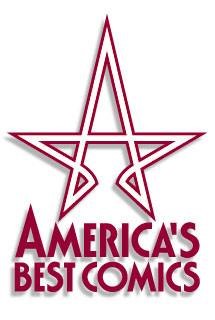 Moore intended to create a whole little universe, for Wildstorm; but, he decided to keep the League of Extraordinary Gentlemen for himself and artist Kevin O'Neill. He was excited at the prospect of doing superheroes again, but the way he wanted, with editorial freedom. Then, fate intervened to mess with him. Jim Lee sold his imprint to DC Comics and accepted a position as an executive at DC. After the fallout of the Speculator Bust and the distribution wars touched off by Marvel purchasing Heroes World, to self-distribute their comics (which resulted in Marvel's bankruptcy), comics were in a severe decline. Lee went looking for a buyer to take his company off his hands and let him focus on art and producing comics, while someone else deals with the financing and publication. Alan Moore was caught in a bad position. he made a deal with Jim Lee, a man he trusted, who just sold his company to the very people that Moore considered the enemy and had refused to ever work with, after they effectively swindled him and Dave Gibbons out of Watchmen, in perpetuity and reneged on multiple promises, while making loads of cash off his name. To fans, it looked like this line of exciting-sounding comics was dead before it ever launched, as no one believed Moore would work for DC, even if pressed by contracts. A solution was brokered. DC would have no direct editorial input into the ABC line, as Scott Dunbier would be Moore's only contact, as he was the editor coordinating the original project, for Wildstorm. Moore was willing to compromise because he had promised work to several artists he had collaborated with on Liefeld's books. So, the line went ahead, with Moore acting like DC wasn't involved and DC mostly keeping their hands out of things, until they couldn't keep their itchy fingers out of the line and started messing with the status quo, fairly early in their relationship. The end result was a short-lived but massively entertaining batch of comics, that took old archetypes and gave them a fresh coat of paint, took up the challenge of Phillip Jose Farmer's Wold Newton Universe, and explored Moore's fascination with Magick (the esoteric stuff, rather than the stage variety_ and reality. It also demonstrated that Beardy McGrumpypants had a pretty darn good sense of humor as these comics were fun, with a capital F. While other comics were competing to see who could bring in a bigger bodycount or illustrate more viscera, Moore was busy doing police procedurals, sentient protoplasmic lifeforms, boy geniuses, and a superhero group of Victorian literary characters, in a world with more easter eggs than a Rankin-Bass holiday special. So, join me and Alan Moore, as we explore the world of ABC. It's easy as 1...2...3...... Yup, kiddies; Michael Jackson and his brothers once had their own cartoon. Remember when that was the most unusual thing about them? Rankin-Bass also did one for the Osmond Brothers.... And people though Sid & Marty Krofft were smoking weird stuff! |
|
|
|
Post by codystarbuck on Sept 28, 2022 20:04:24 GMT -5
League of Extraordinary Gentlemen #1 Creative Team: Creative Team: Alan Moore-writer, Kevin O'Neill-art, William Oakley-letters, Benedict Dimagmaliw, Scott Dunbier-editor Synopsis: In the year 1898, at Dover, a government figure, Campion Bond, meets with a Miss Wilhelmina Murray, as they stand on the unfinished bridge that will link the island of Great Britain to the European continent....  ...awaiting the arrival of a sea captain, miss Murray's sole recruit for this endeavor. Mr Bond remarks about the man's supposed instability, as well as Miss Murray's recent divorce and the rather sorted affair of her being "ravished" by a "foreigner." Miss Murray is quite the exile from polite society. Miss Murray remarks about the identity of their mutual superior a mysterious "M," who she believe to be Mycroft Holmes. Bond tells her to forget about who M may be and focus on the man she is to find in Cairo, to alert that his country needs him, again. We move to Cairo, where Miss Murray moves through a seedy portion of the Casbah, where she is led to am emaciated old man, who is in the throes of opium addiction.... 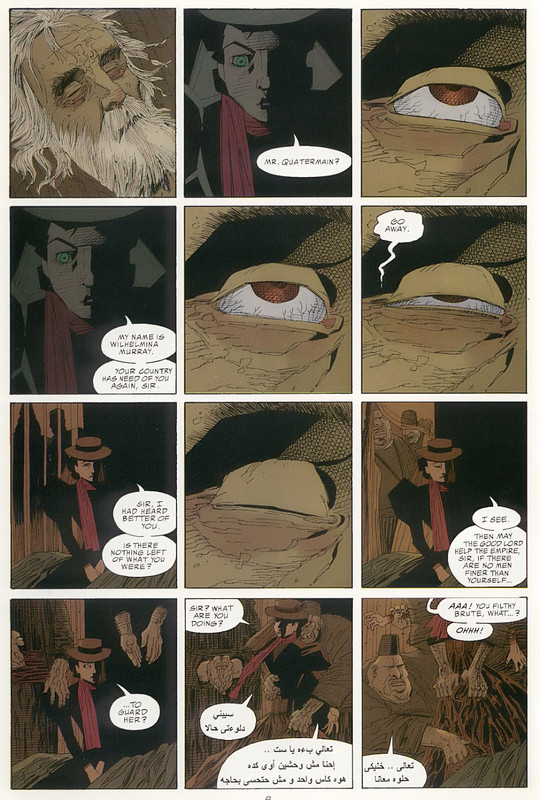 He tells her to go away and she berates his lack of character, looking for any sign of the man who once was. She finds herself assaulted, from behind, by two men, who seem interested in pleasures other than opium. One holds her down while the other drops his pants and prepares to force himself on her, when the decayed hero produces a Lemat revolver and shoots the would-be rapist dead... 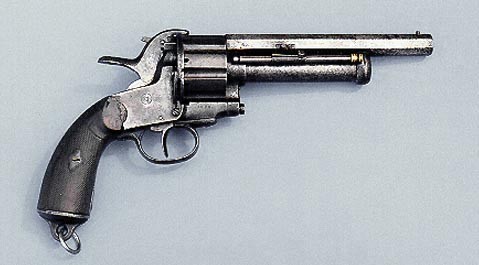 The other man is faster and stronger and grapples with the decrepit white man, while brandishing a long knife. The white man cannot bring his pistol to bear and is saved from death by Miss Murray, who sticks another knife into the back of the Arab. She suggests to Mr Quatermain that they make a hasty exit from the place. He agrees and follows. Mina Murray leads Allan Quatermain through the warrens to the docks, where their transport awaits them. 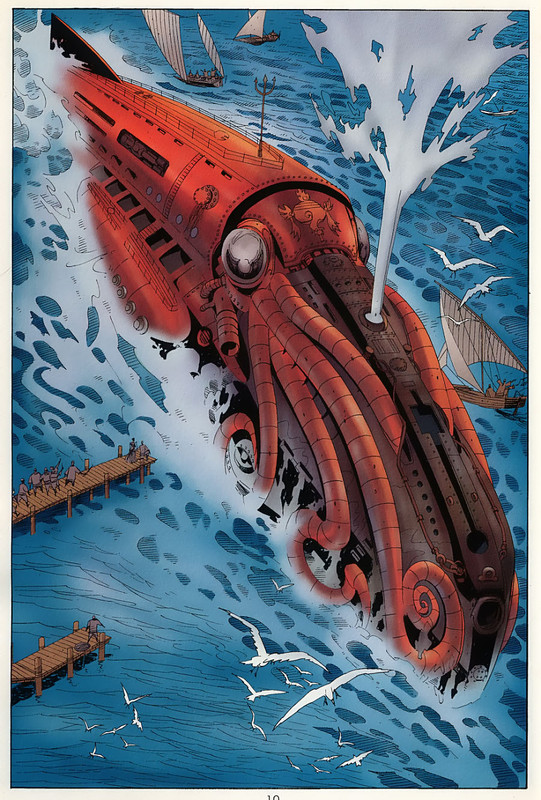 The great hunter and adventurer believes he is still "chasing the dragon," until a hatch opens in the hull and the couple come face to face with Prince Dakar, better known as the science pirate Captain Nemo. The time for pleasantries is short as Mina points out the mob pursuing them, which Nemo dismisses as a "Mohammedan rabble" and he dispatches the leader with an advanced harpoon firing gun, which impales him and hurls him across the crowd, stunning them into inaction, as he seals the hatch and the craft descends into the ocean. The scene shifts to Paris, where the detoxed Alan Quatermain and Miss Mina Murray move on to rendezvous with their contact, C Auguste Dupin, noted detective. He has been in contact with Campion Bond and leads them to the Rue Morgue, where in 1941 a woman and her daughter were killed in horrible fashion. The killings have begin again. Previously, Dupin believed the murders were committed by an escaped Orang-outang, owned by a sailor. However, these killings are the same, all the women are prostitutes. Mina offers to disguise herself as a lady of the night, to bait a trap for this ape-like killer. Mina dresses in a provocative outfit, though she refuses to remove a neck scarf when Dupin sugegsts it. She positions herself below a street lamp, while Dupin and Quatermain take up positions to watch for a potential assailant. The wait for some time and the craving starts to gnaw on Quatermain and he leaves his post to go into a nearby pharmacy and buy a bottle of laudanum. When he returns, Mina is gone. he calls Dupin and says she was just here, but Dupin notices the laudanum and berates the Englishman for his weakness. The go and question the other streetwalkers for any info about Mina. He earns that she went off with a client of one of the women, a small Englishman, named Henry. He is a regular and lives around the corner. Quatermain suggests she might have though he was the doctor they sought, but Dupin sugegsts keeping their pistols close at hand. they go to the address and arrive in time to see Mina hurled outside. She says she went inside with the doctor, but a change came over him. Allan leaves Mina with Dupin and advances into the room, his Lemat at theready. it is not enough... 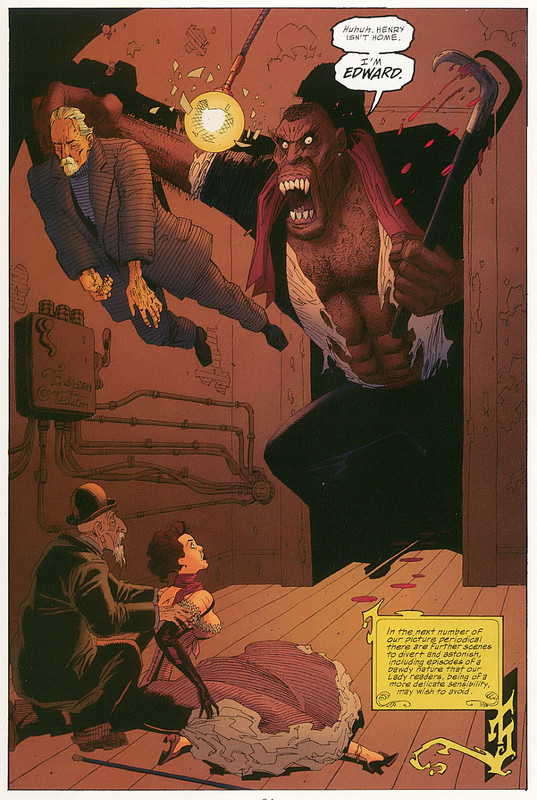 The rest of the issue features the first chapter of a text piece, Allan and the Sundered Veil, an adventure of Allan Quatermain. Allan comes to England, to a decrepit old castle, where he meets Lady ragnall, who possesses taduki, a narcotic that allows one to see into the past. Thoughts: A brilliant opening chapter to Moore's mash up of Victorian pulp literature and modern superhero adventure. Moore crafts a superhero team that is filled with Victorian adventurers, from some of the great works of literature, either as direct actors or supporting and even background characters. He begins with an original creation, Campion Bond, whose very name suggests intrigue, as it mixes Ian Fleming's James Bond and Margey Allingham's Albert campion, an aristocratic adventurer and detective, created, originally, as a parody of Dorothy Sayers' Lord Peter Whimsey. Mina Murray is none other than Mina Harker, the bride of Jonathan Harker, in Bram Stoker's Dracula. Mina becomes the target of the vampire, once he has drained Lucy Westenra. It is only the intervention of Dr Abraham Van Helsing and a group of friends that saves Mina is saved. Moore takes this Victorian tale and applies Victorian mores to its outcome. Within Victorian society, propriety was everything and Englishness a virtue and Mina was the victim of a foreign count, in a series of near-sexual encounters. Although she is innocent of any wrongdoing, gossip would reduce her to a tainted woman. For an ambitious solicitor like Jonathan Harker, the stain might be too much to bear in marriage. There is even the hint that Mina may not have been so innocent; or, is at least perceived to have been somewhat willing. The end result is divorce from Harker and a resumption of her maiden name. For whatever reason, she has been recruited by Bond to assemble a team to serve the nation. Mina Murray represents the New Woman of the Victorian age, as a portion of female society sought to move into the male-dominated portions of society, particularly the professional fields. The cause of women's suffrage became a rallying point, as woman challenged the norm and demanded their equal. This would spur on other groups, eventually leading to women's suffrage in the 20th century and setting women on the path tomore equal positions within Western society. So, she is an outcast for many reasons, for being a "fallen woman," and for challenging society's structure. This makes her an interesting figure around which to build a League of Extraordinary Gentlemen. of course, it is still Victorian Society, so only those Gentlemen are considered Extraordinary, and not Mina, who is actually the most extraordinary, as she is clearly the leader of this group. Allan Quatermain is the hero of a series of adventure novels, by H Rider Haggard. Quataermain is a noted white hunter and explorer, living in colonial Africa. His most noted adventure is King Solomon's Mines, where he acts as guide to an expedition to locate a woman's missing father, as he sought the legendary source of Solomon's wealth. Haggard was the granddaddy of jungle adventure writers, giving us the white hero in darkest Africa. Quatermain is the quintessential Great White Hunter, who can best any African warrior and kill any wild animal. However, that was some time before. The reality here is that the legend became an old man and sought escape from his heroic impotence in opium. Mina locates him and brings him back to the nation he once served. He is a weak man, a shell of his former self, but, he will regain his strength, thanks to Mina's leadership. Mina's first recruit was Prince Dakar, aka Captain Nemo, created by Jules Verne, in 20,000 Leagues Under the Sea (which refers to the distance the Nautilus travels, not the depth it descends) and its sequel, The Mysterious Island. nemo warred against the Western world, destroying warships in a demand that colonies be freed and war between nations be ended. Originally, Verne intended Nemo to be Polish, a revolutionary; but, his books sold well in Poland and his publisher convinced him to make Nemo stateless and the Prince Dakar identity only emerged in Mysterious Island, where he is made Indian, a part of the Sepoy Rebellion. Moore and O'Neil treat him as Indian, both in costuming and attitude, as his reference to a "Mohammedan Rabble" suggests, invoking the bitter fighting between Muslim and Hindu in Indian history. We also see Hindu statues and art on his submarine (I can't recall if Moore ever calls it the Nautilus or suggests it is a successor vessel to the original, which was supposed to suggest a narwal, not a squid). Nemo was seen as a renegade and pirate, by the Western world and keeping him as an Indian, rather than a James Mason figure further alienates him from Western (read "white") society. Our last member, revealed at the end, is one Edward Hyde, a murderous monster, created by Robert Louis Stevenson, in The Strange Case of Dr Jeckyll and Mr Hyde. Dr Henry Jeckyll creates a potion which separates his worst nature from himself, but it creates a figure of pure evil and malevolence in an alternate personality, Edward Hyde. It is probably the earliest major representation of multiple personality disorder, though manifested in a physical transformation. It also depicts Freud's concepts of the ID, Ego and Super Ego, as Hyde is the Id unrestrained. Hyde is this group's Hulk, though Edward Hyde is a smallish figure in Stevenson's story. However, Moore took his concept from a passage that remarks about Hyde seeming to grow as he is released again. Hyde would seem a stereotypical brute and monster in this; but, he ends up being one of the more interesting figures, as moore progresses into new adventures. Also appearing here is C Auguste Dupin, Edgar Allen Poe's detective, from "The Purloined Letter," "The Mystery of Marie Roget," and "The Murders in the Rue Morgue." Moore pokes fun of the latter, which was the debut of the character, where the murderer turns out to be an orang-outang, despite the illogic of that. Here, we see it is Edward Hyde, who returns to his actions. Now, the rear cover suggests a fifth member of this League, who is not Campion Bond. We see a gloved hand, with the other four; but, note a gap between kid glove and shirt cuff. That figure is the scientist, Griffin, the titular figure of HG Wells' The Invisible Man. In the novel, he is known only as Griffin and the Universal film, with Claude Rains, called him Jack Griffin. Moore calls him Hawley Griffin, mixing the surname of the novel with the historical Dr Hawley Crippen, who murdered his wife and hid the crime for some time, before a search of his house located the remains of her body. Griffin will appear in the next issue, which Moore sort of previews in the back pages, which mix actual Victorian magazine advertisements with fictional ones, including a notice for a detective, who seeks cases like those solved by the late Sherlock Holmes and says to send enquires to S. Blake, which is Sexton Blake, the detective figure who was a copy of the Holmes model and appeared in stories and novels for years, including under the editorship of Michael Moorcock. There is an ad in there for Rosa Coote's Correctional Academy for Wayward Gentlewomen. The image of a whip suggest what kind of correction Miss Coote administers. Rosa Coote was a dominatrix figure from several Victorian erotic BDSM stories, including The Convent School and "Miss Coote's Confession," in The Pearl, a Victorian magazine devoted to pornographic stories. As we can see, Moore has filled this imaginary world with literary figures from a variety of sources and even genres. He also depicts them and their world with Victorian mores and expressions, unpleasant as they may be to modern eyes. In doing so, he satirizes the racist and xenophobic nature of much of Victorian literature (and other societies of the same era, it must be said), while maintaining the conceit of the comic being a sort of found penny dreadful paper. Moore is following in the footsteps of Phillip Jose Farmer, whose Wold Newton Universe sought connections between extraordinary literary figures, both heroes and villains, through a fictional biography of Tarzan (and, later, Doc Savage). The name refers to a village, Wold Newton, in England, that was the sight of a meteor crash. A group of passersby are exposed to radiation from said meteor and they and their descendants go on to be major figures in society, either for great good or evil. Among those present of descended from them are Sir Percy and Lady Marguerite Blakeny, aka The Scarlet Pimpernal, and Dr Fu Manchu, HG Wells' Time Traveller, Sherlock Holmes, The Shadow, Captain Peter Blood, Lord Peter Whimsey, Monsieur Lecocq and others. Farmer extended this further, with a meeting between Tarzan and Sherlock Holmes (and several other adventurers), in The Peerless Peer, the idea of Phileas Foff as an agent of an alien race, in The Other Log of Phileas Fogg, and a link between Tarzan (or Lord Grandreth) and Doc Savage (Doc Caliban) and The Nine Unknown, from Talbot Mundy's novel and the writings of Helena Blavatsky, the founder of Theosophy. Michael Moorcock played in this concept, a bit, in his Oswald Bastable books, where the character from E Nesbitt's children's tales is an adult, in the British Army, who ends up in an alternate universe where the British Empire still stands, thanks to aiship travel. Bastabale becomes mixed up in plots by revolutionaries and historical figures such as Lenin and Chruchill also appear, as well as some of Moorcock's other figures, from his Eternal Champion stories. In recent years, Kim Newman has dabbled in such meta-fictions with his Anno Dracula stories, which take Stoker's work and mixes in Jack the Ripper, other Victorian Vampire figures, World War I adventure heroes (Biggles, Captain Midnight, the Shadow's alias, Kent Allard), movie vampires (Count Orlock and others) and figures from film, television and literature. Jean-Marc and Randy Lofficier furthered this with other authors, using figures from French pulp literature, in the Tales of the Shadowmen anthologies. Moore creates an intriguing world that O'Neill matches with fantastic images, taken from future predictions of the age and tales from literature, as we see Paris overflown by multiple airships and the initial meeting on a transcontinental bridge, linking England and France, as the future Channel Tunnel would. O'Neill further adds little touches like actual Vicrian advertising signs and propaganda posters and the like. We will meet more figures taken from novels, short stories, penny dreadfuls, pulp novels and comics. The work is so dense that Jess Nevins catalogged the easter eggs in a series of companions, which were an outgrowth of a website he created to provide annotations for the stories, as well as the other ABC works, including Top Ten. Monkey Brain Books collected these annotations into books, which are sadly out of print, though a great reference for the series. I have a longstanding love affair with great adventure fiction and books, in general, stemming from my father taking us each week to the bookmobile, from the decatur Public Library, which came out to our small town weekly. I would step onto a bus full of wonder and pick out items to read and devour for a week, then return them for something new. Our school library added to that wonder and my teen and adult years found me (and, often, my father) going into nearby bookstores and exploring their wares. One thing would lead to another and great comic book writers like Roy Thomas would point me to new things, like the pulp heroes, which opened up further worlds to explore. That resulted in what was, for a time, a dream job of working as a manager, for Barnes & Noble, at the time of this comic's publication. When the movie "adaptation" (assassination is more appropriate) was due in theaters, is talked it up and the comic series, setting up a display of the books related to the property, as well as the trade collections of the comics. My hopes that a good movie would introduce the wonders of these literary works to a new generation proved unfounded, but, it nudged me into exploring more characters, leading me to the Tales of the Shadowmen works, which further led me to the original stories of characters like Fantomas and Arsene Lupin. Half the fun of this series is picking out the easter eggs and spotting characters.
|
|
|
|
Post by codystarbuck on Sept 28, 2022 20:34:22 GMT -5
ps League of Extraordinary Gentlemen is probably the darkest of the ABC line; but, it also remained relatively separate, as Moore and O'Neill retained ownership. DC owns the three books they publish (or have exclusive publishing rights, which is pretty much the same thing); but, the pair own the series and concepts, though most of the characters are in the public domain. Moore would add some public domain superheroes to ABC, via Tom Strong, down the road.
I know the subject of rape and Moore's writing will come up; so, I will say, the attempt on Mina, in Cairo, is in keeping with such Victorian tales, where virtuous Englishwomen were targeted by foreign devils or underclass criminals. As with other elements of Victorian writing and attitudes, Moore is doing the same here. I don't see it as a trope in his work. From my perspective, critics of Moore go looking for instances of it turning up (or similar things) and ignore the similar prevalence in the work of other writers, within comics. I'm not defending Moore; but, I think his critics go to as much extreme as some of his defenders do. I will say that a trope or cliche in Alan Moore's hands is far more likely to be part of a great story than most other writers.
|
|
|
|
Post by Batflunkie on Sept 28, 2022 21:09:21 GMT -5
I've said this before, but I feel like it bares repeating: I love ABC! It was one of, if not the main reason, for me falling in love with comics even if I did read Tom Strong, Tomorrow Stories and Top Ten at an incredibly young age
|
|
|
|
Post by badwolf on Sept 29, 2022 9:17:10 GMT -5
I really enjoyed Tom Strong's Terrific Tales though I have to admit I only bought it for Jonni Future.
|
|
|
|
Post by codystarbuck on Sept 29, 2022 13:49:49 GMT -5
I really enjoyed Tom Strong's Terrific Tales though I have to admit I only bought it for Jonni Future. That was my favorite feature in it; but, tesla Strong's adventures were usually pretty good, as were the Young Tom Strong tales. Promethea is the only book I didn't read, at the time, and have only sampled a little, since, so this gives me an opportunity to read the whole thing. Given that it was more woven into Moore's Magick ideas, I kind of had little interest in it, originally, until I started hearing comparisons of it to Wonder Woman, in terms of how the hero was being developed. However, I had to wait for it to be collected, since I missed the early stuff. Tomorrow Stories had to grow on me, a bit and I was a little iffy on Top 10, at first, until I got deeper into it and started really devouring the easter eggs and also delighting in things like the Atomic Mice. I think it was the gods issue, where Loki drops the pseudo-Shakespeare cliche and speaks in a modern fashion that clinched it for me as something more than the initial mystery. Tom Strong was my favorite, in terms of story (with the League a close second); but, Top 10 became my favorite, visually, for all of the background details and sight gags. I loved the fact that when they did the 49ers graphic novel, set in the past, they went backwards with the easter eggs, making them newspaper strip characters, instead of comic book, sci-fi or film. Seeing the Pogo gang as actual animals and realizing who they were was hilarious, not to mention seeing Smokey Stover as an actual fireman. |
|
|
|
Post by codystarbuck on Sept 29, 2022 13:53:51 GMT -5
ps i intend to cover everything, but only the League up through Black Dossier, since that was the end of it as part of the ABC line. I might pick up the remainder, in a separate thread. I will not cover the post-Alan Moore stuff, though, as I quit when he did. It was not the same material. I will include Terra Obscura, even though he didn't write it, as he was still involved with the line when it came out and grew out of what he had done in Tom Strong. Plus, I enjoyed it and love the Nedor heroes, for their visual appeal.
|
|
|
|
Post by Hoosier X on Oct 1, 2022 1:56:55 GMT -5
I want to read Top Ten again. My first issue was #6, I got the issues I’d missed almost immediately and I thought it was one of the most amazing thing I’d ever seen.
I used to read it every so often but I haven’t read it for a while.
|
|
|
|
Post by codystarbuck on Oct 3, 2022 0:02:09 GMT -5
League of Extraordinary Gentlemen #2 The cover is meant to represent a series of cigarette cards, which was a loyalty marketing gimmick perpetuated by tobacco manufacturers, before bubble gum companies picked up the idea. Note that there are separate cards for Dr Jeckyll and Mr Hyde. Campion Bond is wearing a cricketer's outfit and cap, which was a pastime often featured in Victorian adventures and subsequent literature, such as the Raffles series of stories. Crickett was synonymous with the Gentleman Adventurer, while football was for the lower classes. Creative Team: Alan Moore-writer, Kevin O'Neill-artist, William Oakley-letters, Benedict Dimagmaliw-colors, Scott Dunbier-editor Synopsis: At the end of last issue, Chevalier Dupin, Mina Murray and Allan Quatermain had discovered Edward Hyde, who battered Mina and has knocked Quatermain senseless. Dupin unloads a pepperbox pistol to the side of Hyde's face and manages to shoot off part of his ear. He goes to attack Dupin and Mina and Quatermain has regained his senses enough to leap onto Hyde's back and shove a bottle into his mouth, which shatters against Hyde's teeth, filling his mouth with the laudanum that Quatermain had purchased to feed his cravings for opium. It manages to knock Hyde out, though Mina is rather upset when she learns what was in the bottle. They secure a cart and haul Hyde's unconscious body down to the waterfront and to the Nautilus (which is definitively named, in this issue). On the voyage back to England, Mina writes out a report, taking issue with the lack of briefing about Hyde, by Campion Bond...  The dock in London and Mina reports to Bond, though she is hardly subservient. She once again suggests that M is Mycroft Holmes. The men are put in the care of Inspector Donovan (one of the earliest detective characters, predating Sherlock Holmes, in the UK), while Bond warns Mina about further speculation as to M's identity. He remarks of Sherlock's death (at Reichenbach Falls, in "The Final Problem"), has emboldened the enemies of the British Empire and speaks of Robur the Conqueror (From Jules Verne's Clipper of the Clouds, aka Robur the Conqueror and Master of the World) and that the astronomer, Lavelle, has noticed strange images on Mars (from War of the Worlds). He further remarks of strange "miracles" as Rosa Coote's, which have drawn the ire of the Rev. Septimus Harding (from Anthony Trollope's The Warden). Young girls, all virgins, have become impregnated by "The Holy Spirit." This is to be Mina's next stop, to find the next recruit, a medical student named Hawley Griffin. Mina confers with her colleagues and remarks that Griffin was believed involved in a murder, though a dead albino man was identified as Griffin. Griffin was not an albino, Mina remarks. Jeckyll is entrusted to Bond for treatment to try to control his changes and control Hyde. The group arrives at Miss Rosa Coote's Correctional Academy for Wayward Gentlewomen and are greeted by the headmistress, herself.... 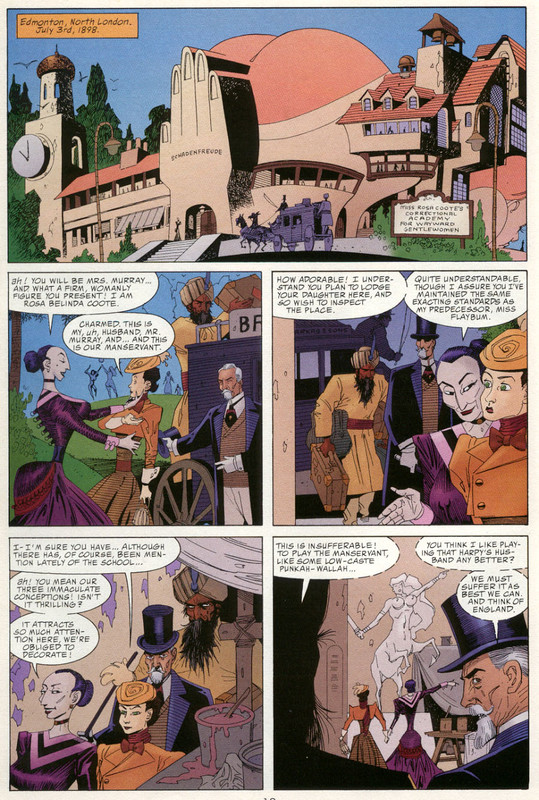 She delivers a very "hands-on" greeting to Mina and her "husband and servant," as Quatermain masquerades as the husband and Nemo as the manservant. Nemo is not happy about masquerading as a low caste servant and Quatermain is not enthused about portraying a husband to Mina, as a liberated "harpy." Mina brings up the strange events and Miss Coote acts excited and mentions redecorating going on, due to the attention. Mina is pretending to be a parent, inspecting the school before possibly enrolling a daughter there. they are given a tour and see a teacher caning one Olive Chancellor (from Henry James' The Bostoners) and are introduced to one of the pregnant girls, Becky Randall (Rebecca of Sunnybrook farm). miss Coote remarks that all of the "visitations by the Holy Spirit" have all occurred in the same wing, which is where the group is lodged, for the night. They note the rather lascivious decor and, when alone, Mina remarks that teh decorators are more likely to be the fathers of the unborn children. Nemo complains about the charade and assumes Mina will take the spare single room, while the two men take the double. Mina is not THAT liberated, when it comes to comfort. Quatermain and Nemo compare notes, one the great Colonial adventurer, the other a great Colonial Rebel. Quatermain mentions his deceased wife and son, buried in Africa and both speak of a love for adventure. They hear load cries and moans and rush into the other room, where Mina is also awake and trying to locate the source. they head towards the dormitory and a girl runs past, saying the "Holy Spirit has got Polly." They rush into the dorm room to find the girl, Polly (Pollyanna Whittier, of the book Pollyanna), floating in the air, her legs spread apart, crying out in surprise and pain. They rush to the girl and Mina tries to grab hold of her and can feel another physical presence. She tells Quatermain to help and he feels something like skin and tries to grab around some unseen object. Nemo lends a hand and gets his arms around what seems to be a throat, but gets headbutted. Nemo yells to block it from leaving the room and Mina stands in the doorway, holding a pail. She hurls paint from it and it hits the invisible object, revealing it.... 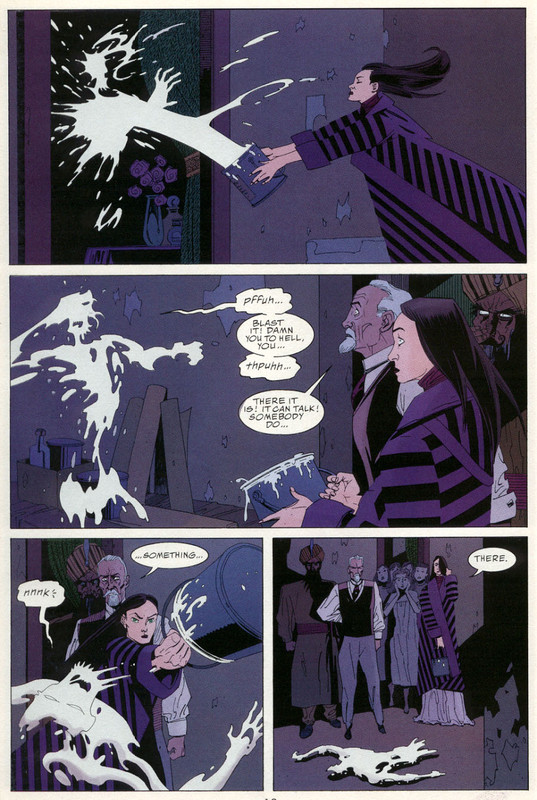 Mina then smashes the pail into the head of the revealed man. She has secured Hawley Griffin, aka The Invisible Man. Miss Coote turns up to investigate the noise and Mina reveals their identity and mission and turns Polly over to her for care, while Polly vows to remain optomistic, despite being "manhandled by a demon." The team departs back to London, in a coach. The group meets again at their new headquarters, in a secret annex of The British Museum... 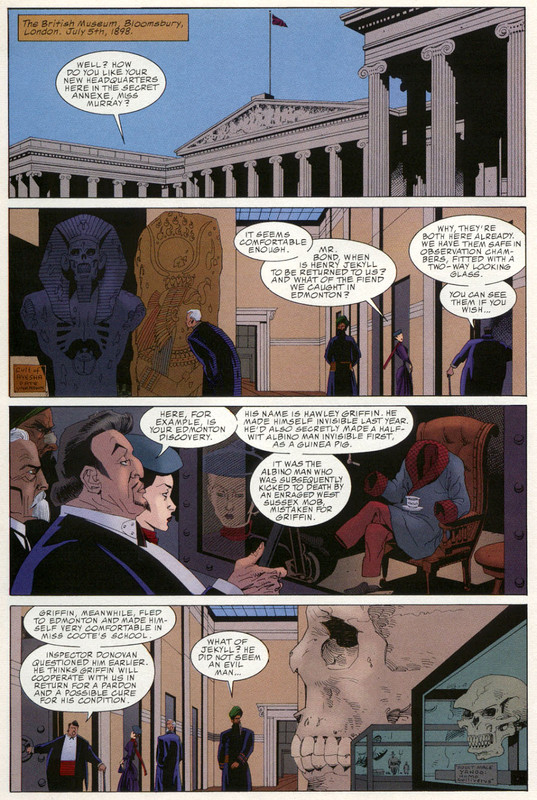 Griffin is housed in a glass fronted cell, among other oddities, as Quatermain examines a sarcophagus, with the notation of the Cult of Ayesha (from H Rider Haggard's She, as well as Ayesha, The return of She; She and Allan and Wisdom's Daughter). Bond says Donovan has interviewed Griffin and suggests he will work with them, in exchange for a pardon and cure for his condition. They see another room, through glass, where Donovan interrogates Hyde. They learn that Jeckyll faked a suicide and fled to Paris and no longer needs his potion to change, as stress will accomplish it. The are taken to another room, where they meet Professor Selwyn Cavor (of HG Well's The First Men in the Moon), who asks Bond if they are the ones who will retrieve his Cavorite. The metal was stolen by a warlord, a depraved individual, who was part of the Opium Wars.... 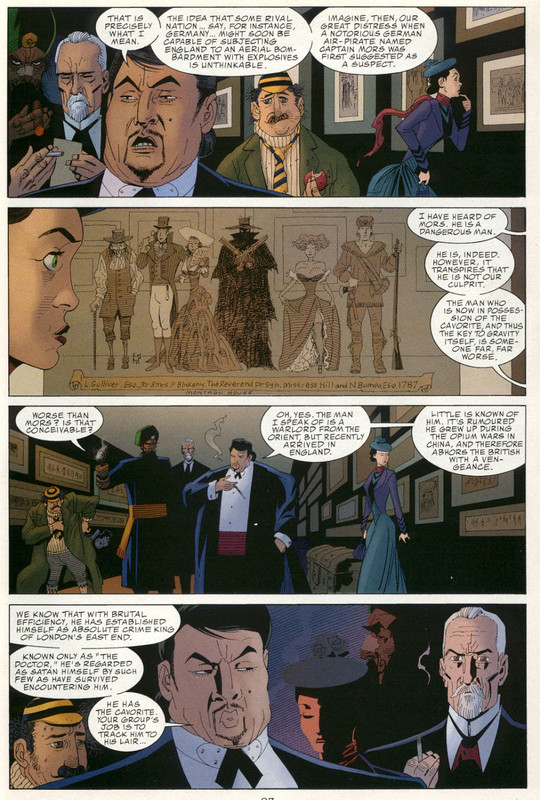 {Mina scrutinizes an etching of the original League, with Sir Percy and Lady Marguerite Blakeney (of The Scarlet Pimpernel), Lemuel Gulliver (of Gulliver's Travels), The Reverand Dr Christopher Syn (from Dr Syn: A Tale of Romney Marsh), Fanny Hill, and Natty Bumpo (aka Hawkeye, of The Leatherstocking Tales series, by James Fenimore Cooper)} At first they thought the German Kapitan Mors (from Der Luftpirat und sein lenkbares Luftschiff, aka The Air-Pirate and His Steerable Airship), but Bond says it is the East End crime lord, known as "The Doctor" (not the Time Lord, but a certain crime lord, in the Limehouse District). There job is to locate his lair and retrieve the Cavorite, before it can be used to create a devastating aerial weapon. Allan and the Sundered Veil continues, as Allan takes the drug, taduki, and is in the throes of a vision. Only the black maid, Marissa, who has repeatedly taken the drug, can see what Allan sees, his body turned inside out and a strange dimension of non-Euclidian shapes. She says he has not been taken to a past life, but to beyond the world as they know it, to another dimension. Allan finds himself in a violet world, where he runs into two men, Captain John carter, an ex-Confederate soldier, who was dying in a cave, when he felt himself pulled to Mars, and his great nephew Randolph Carter, of Providence, RI. The men hear strange sounds and cries and Allan grabs a burning limb from a fire, which reveals creatures that have centipede-like shapes, gelatin appearances, elements of frogspawn and other amphibian and crustacean forms. The creatures are horrible and Randolph is terrified, to his great-uncle's consternation. he draws his sword, ready to fight these creatures, as Allan holds his torch like a club. Another man apepars, on a strange floating contraption. he calls himself the Time Traveler and invites the others to climb aboard his machine. (So, we have Luna Ragnall, from the Allan Quatermain novels, John Carter of Mars, HP Lovecraft's Randolph Carter, and HG Well's unnamed Time Traveler). Thoughts: Moore completes the assembling of his League, first securing Mr Hyde, as the group's Hulk and we learn that Jeckyll has become like Bruce Banner, turned into the monster in times of great stress. Dr Jeckyll & Mr Hyde was one of the two inspirations for the Hulk (the other being Frankenstein) and Moore reverses things, making the pair of Jeckyll and Hyde into a representation of their comic book descendent. Moore's Hyde is a vulgar brute, who swears and rants racist and other bigoted slurs, representing the worst natures of man, the fear and hatred of the unknown and those different. When he first reverts back to Jeckyll, we see that the wound is transferred to the doctor, as his missing ear has to be sewn up. Moore formally identifies Nemo's ship as the Nautilus, which greatly deviates from Verne's description, but homages the squid attack upon the Nautilus. Perhaps this is an upgraded version of his craft. Bond continues to be a mysterious superior to the group, though not as mysterious as M, who Mina believes is Mycroft Holmes. Within the Holmes stories, Mycroft is Sherlock's older and smarter brother, who works in some capacity, for the British government (Holmes tells Watson that Mycroft "is the British Government."). Billy Wilder's The Private Life of Sherlock Holmes presents the idea that Mycroft is head of the British Secret Service and his Diogenes Club is a front for the organization. Later, writer Kim Newman used this conceit for his own meta-fictions, The Man From the Diogenes Club, as well as the Anno Dracula series (which is sort of an alternate dimension from the other series), where the Diogenes Club is the branch of the Secret Service that deals with strange phenomena and creatures; a sort of mix of Dr Who, The Avengers, Sapphire & Steel, The Champions and Adam Adamant. Bond never confirms this and suggests Mina keep her ideas to herself, as M's identity is a State secret. We are told that Sherlock is believed dead, after battling Professor Moriarty, in "The Final Problem." Doyle wrote that story, as he had grown tired of Holmes and wanted to move on to other works, killing the detective after introducing his greatest adversary (with this being their only adventure together). Public demand led first to The Hound of the Baskervilles, then to the return of Sherlock Holmes, where Watson learns (in "The Adventure of the Empty House") Holmes faked his death, though Moriarty did fall to his, then spent time in Europe, earning a living as a violinist. Later writers turned this into fact, as Nicholas Meyer had Holmes consult with Sigmund freud, to deal with his cocaine addiction and then take a recovery sabbatical, telling Holmes to write that he had been killed by his mathematics tutor, Moriarty. Meyer wrote another Holmes adventure, The Canary Trainer, where Holmes is a violinist in the orchestra of the Paris Opera House, where he witnesses and investigates the events of Gaston Leroux's The Phantom of the Opera. Meyer had a third Holmes book, The West End Horror, that revolves around the productions of Gilbert & Sullivan, and also features a young George Bernard Shaw. Rosa Coote's students are all girls from literature, as noted above, including Pollyanna. So, you can imagine a film version of the League (rather than the failed attempt), where Hailey Mills is floating in the air, the victim of Claude Rains. That's the horrible vision I got when I first read that scene, as the Disney Pollyana is my relationship to the literary work. I find it hard to see Pollyana playing the Glad Game, after that; but, that was the point of the character. Moore, of course, would bring together other literary young heroines, in Lost Girls, with Dorothy Gale (Wizard of Oz and other Oz books), Wendy darling (Peter Pan) and Alice Fairchild (Alice's Adventures in Wonderland and Through the Looking-Glass), in an erotic tale, along with his partner, Melinda Gebbie, who also collaborated on the Cobweb feature, in ABC's Tomorrow Stories. Moore mention's Griffin's death, at the end of Wells' book, but gives him an out, as he substituted someone else. Professor Cavor is at the center of Wells' The First Men in the Moon, where he creates a vessel out of cavorite, which has anti-gravity properties, which carries him and companions to the moon, where they have an adventure. Here, we learn the substance has been stolen by a criminal doctor, to create an aerial weapon. This crime lord is none other than Dr Fu Manchu. Moore refers obliquely to him, since he was still trademarked by Sax Rohmer's estate and the first book hadn't yet entered the public domain. This was also the reason why marvel could not refer to Fu Manchu, in relation to Shang Chi, after they lost their license to those characters, until the earliest story entered the public domain, in recent years. He makes it quite plain, describing an evil doctor, like Satan, who resides in the Limehouse district. the story told by Rohmer (Arthur Henry "Sarsfield" Ward) was that he was in the Limehouse district and spied a Chinese man of pure malevolent visage, like the face of Satan; allegedly, an actual criminal figure. Limehouse was an area of Chinese residence and there were vice dens and criminal groups, though much of Rohmer's descriptions were racist stereotyping. Fu Manchu's physical description bore more resemblance to stage magician Chung Ling Soo, who was actually a white man, William Ellsworth Robinson, who dressed in Chinese robes and clothing and was made up to appear Chinese. His act and appearance was a copy of an actual Chinese magician, whose stage name was Ching Ling Foo. Moore refers to both Robur and Captain Mors, both of whom were air pirates of the period literature, in France and Germany (respectively) Robur is best known for Master of the World, though the film version is actually, largely, an adaptation of Clipper of the Clouds, aka Robur the Conquerer, where the character first appeared, with a flying heavier-than-air dreadnaught, and some elements of Master of the World, where Robur has a new craft, that can perform in several environments, operating from a mountain base. These references are not just tossed out for similarity, as Moore is setting up later scenes of aerial warships of advanced design. Robur was a sort of aerial Captain Nemo, and the film, with Vincent Price, emphasizes this by having him wage war on arms manufacturers. Captain Mors is a more traditional "pirate," waging war from his airship. HG Wells would also dabble in this in his prophetic work, The War in the Air, which features a vision of a world war, with great airships attacking England, with gas bombs, as many had predicted, after the first World War. Wells also had similar things in his Shape of Things to Come, as a world war devastates civilization, reducing it to barbarous states, until a group of airmen and engineers, operating from a base in Basra, Iraq, set out to stop the warlords and rebuild civilization. In the film version, the airmen, Wings Over the World, fly giant flying wing bombers, which drop sleep gas on The Boss and his forces, subduing them non-lethally. They then build an advanced undergound city, leading to the climax, where portions of society argue and riot at the start of a manned space shot, from a giant cannon. The British Museum is an inspired HQ for the team and Moore and O'Neil fill it with easter eggs, including a Brobdignagian skull, from Gulliver's Travels and relics from Ayesha, the subject of H Rider Haggard's She and other novels. The character was queen of a hidden city in Africa, descended from ancient Greeks, though Moore connects her to Ancient Egypt, before the Greeks. She (literally) will be related to future episodes for Allan Quatermain. Mina observes the image of the first League, which is made up of earlier adventure characters, from the late 1700s and early 1800s, including Gulliver, The Scarlet Pimpernel, Dr Synn, Fanny Hill and Natty Bumpo, aka Hawkeye, of Last of the Mohicans (the inspiration for the nickname of Dr Benjamin Franklin Pierce). This was one of the few elements from the series that made it into the film version, as you see a version of this painting/etching, in the HQ. Too bad they didn't use any of the rest. The Museum will be a source for many future easter eggs, with the Brobdignag skull as a recurring feature. The look of the place brings to mind the trophies in the Batcave, including the giant penny and dinosaur. That is deliberate as Moore and O'Neill draw the parallels to these Victorian figures and later superhero comics. The family tree of the super hero sees the pulp novel hero as their father (and comic strip as mother, or vice versa, if you prefer) and the Victorian and turn of the century novels and story papers as the grandparents. Before someone brings it up, yes, we have two issues of the series and 2 instances of rape (well one actual and one attempted). Both fit in with the context of the story, as the first occurs in an opium den, a haven of sin and vice, as seen by the Victorians. The second is within character for The Invisible Man, who was a deranged maniac, who would engage in such things, as power over others was his ultimate goal and invisibility brought him that power. Meanwhile, Moore is also satirizing both Victorian erotica, as seen in The Pearl magazine, where Rosa Coote existed, with its penchant for flogging and similar BDSM acts, no doubt inspired by the common form of corporal punishment in boarding schools and Victorian (and American) homes. Spanking/whipping/birching/caning was an accepted form of punishment and one of the elements of sexual fetishes is a connection to childhood experiences which created sexual feelings. Fantasies about spanking and related fetishes often revolve around punishment from an authority figure, which was a form of attention. Often in childhood, bad behavior is a call for attention, in the absence of attention with good behavior. Since such punishment might continue into adolescence, it can take on sexual connotations, just as foot fetishes might have a connection to the childhood experiences of crawling at an adult's feet (according to some theories) or clothing to certain sights or smells or sounds, from formative years that bring pleasing images or memories, which then become sexualized. So, Moore is mixing in literary comment and social satire, within an adventure story structure. Sex is a part of Moore's realms, as is power, and rape is an act of assuming power over another, while BDSM activities involve power exchanges and sexual activities. While it is easy to draw criticism for how often such things appear in Moore's work, it doesn't take to much searching to find examples in other comic works, but treated in a far less sophisticated fashion, either in vulgar means or such couched ways as to be more tease than trope. How often is bondage and peril used to sell comics, with overt sexual connotations scrubbed away, while actual use of adult BDSM relationships or activities is used either to represent depravity or is purely the world of erotica? American comics and cinema are rather squeamish and Puritan when it comes to such things, compared to European and other cultures, yet engage far more in the use of violence for drama (especially comics and film). So the question is, is this criticism of Moore based more on how he uses such things, the quantity in which he uses them or just the fact that he uses such adult themes and it makes the more repressed audience uncomfortable, rather than offended? Anyway, I will leave it at that. From here on, I will focus on the plot and the links to other works. Next, Moore unveils the next book in the ABC line, as he turns to the pulp hero to give us a new adventurer: Tom Strong.
|
|
|
|
Post by codystarbuck on Oct 5, 2022 16:50:51 GMT -5
So, I said Alan Moore brought "fun" back to comics, though The League of Extraordinary Gentlemen may not be the best representation of that theme, depending on how you define "fun." LOEG has a satirical, subversive undercurrent to it, which matches the early steampunk writers, particularly Michael Moorcock, who influenced a lot of the comic writers of the UK. His Oswald Bastable stories (Warlord of the Air, Land Leviathan, The Steel Tsar) feature historical and literary characters, in an alternate world where the European powers have maintained their colonies, thanks to airship travel and aerial warfare. Winston Churchill is portrayed as a villain, which fits pretty well with his image in the British colonies, especially India. So, even though Moore is a bit more overt in his satire than Moorcock, there is a dark undercurrent throughout the League, especially since most of the characters come from horror works or were the villains of the tale. Only Allan Quatermain was a true hero of Empire, while Mina was a victim of Dracula, who Moore transforms. With his next concept, Moore just sets out to have some fun with a hero descended from the great Pulp Heroes of the 1910s and 30s. Tom Strong #1 Now that's a cover that grabs your attention! It also pays homage to the great pulp magazine illustrators of the early 20th Century. I am fairly certain I have seen this image from either a magazine cover or propaganda poster. I have tried searching but the closest I get is Rockwell's "The Blacksmith Shop".... 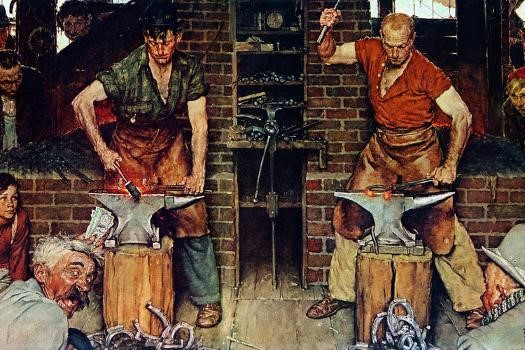 and some other Blacksmith things that face the opposite direction. It has been noted the similarity between Tom and Superman, from Superman #1. 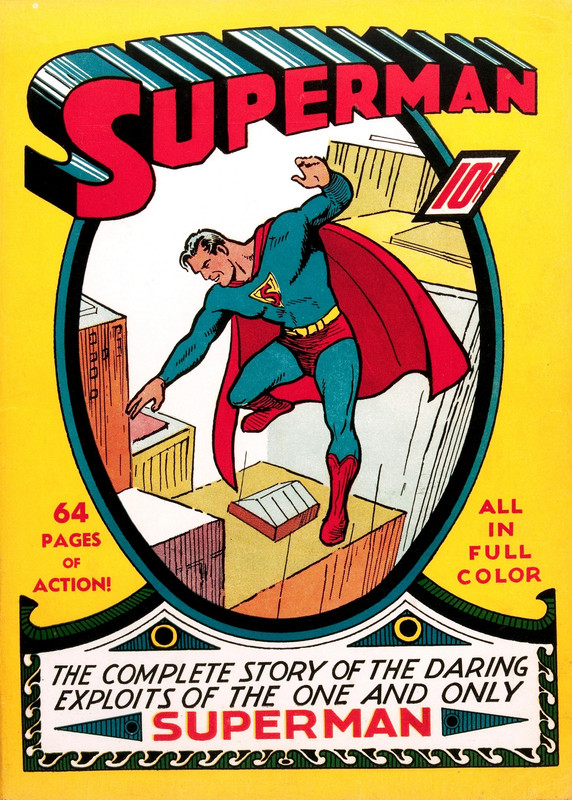 Creative Team: Creative Team: Alan Moore-writer, Chris Sprouse-pencils, Al Gordon-inks, Todd Klein-letters, Tad Ehrlich-colors, Scott Dunbier-editor Synopsis: Young Timmy Turbo receives an envelope from the foreign isle of Attabar Teru, with his Welcome Kit for the Strongmen of America fan society. He joyfully rips it open to see what he got, for $9.99: a certificate, a badge, and a book about his hero, Tom Strong. His mother chides him to get moving or he will miss the car to school. Not a bus, a car; and, not an automobile....  Timmy settles down to read his new book, while the cable car passes through the metropolis, Millennium City, which would make Hugh Ferris' mouth water! He starts to read the story of "How Tom Strong Got Started. The story begins in 1899, somewhere in the West Indies. Sinclair and Mrs Susan Strong are passengers on a ship, when they run into heavy seas and rough weather, seemingly out of nowhere. they are off the mysterious island of Attabar Teru. Sinclair is excited and wants to grab his scientific equipment; but, the mate, Tomas tells him to see to his wife's safety, first. They crash into rocks and a mast snaps off and kills Tomas. The couple find themselves shipwrecked on the island and they set out to rescue their supplies and equipment, before the ship sinks. They bury Tomas, then Sinclair sets about assembling a device, with a steam calculator engine. Sinclair finishes and lights the boiler and brings Pneuman, the Pneumatic Man to life.... 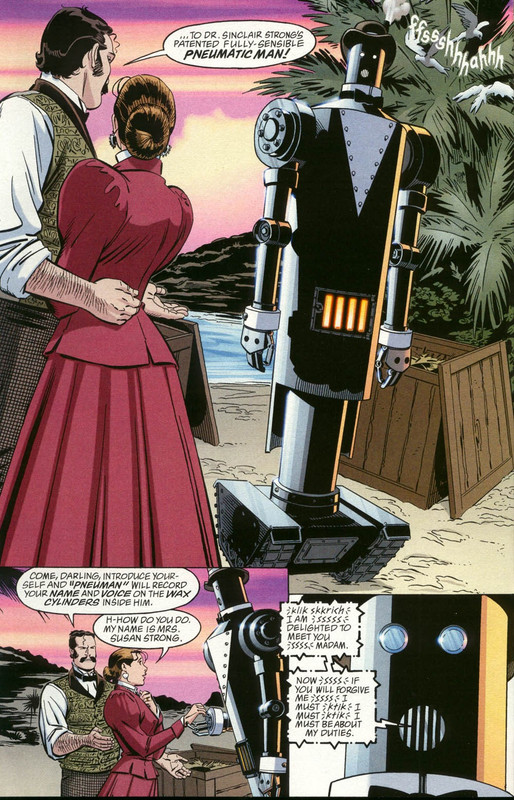 The mechanical servant is sent off to bring logs for a lean-to shelter, for the night, then they will set about creating a more permanent home, in the morning. What Sinclair doesn't see is a set of eyes, watching them from the jungle. They discover an extinct volcano and build their home in its crater and settle down to their new existence. Sinclair's amorus intentions make Susan a bit uncomfortable, in the open air, though only the mechanical eyes of Pneuman sees their lovemaking. Some months later (about 9), Susan is in labor and Sinclair is not equipped to handle complications. The umbilical cord is around the baby's neck and Sinclair doesn't know what to do. To add to his stress, they have visitors...  They are the native islanders of Attabar Teru, but they mean them no harm. The woman helps move the cord from around the baby's neck and midwife the birth of a healthy boy, which they name Tomas, after their slain sailor. Timmy continues to read, oblivious to the excitement outside the cable car, as a blimp-borne bandit tries to stage a robbery. However, help arrives.... 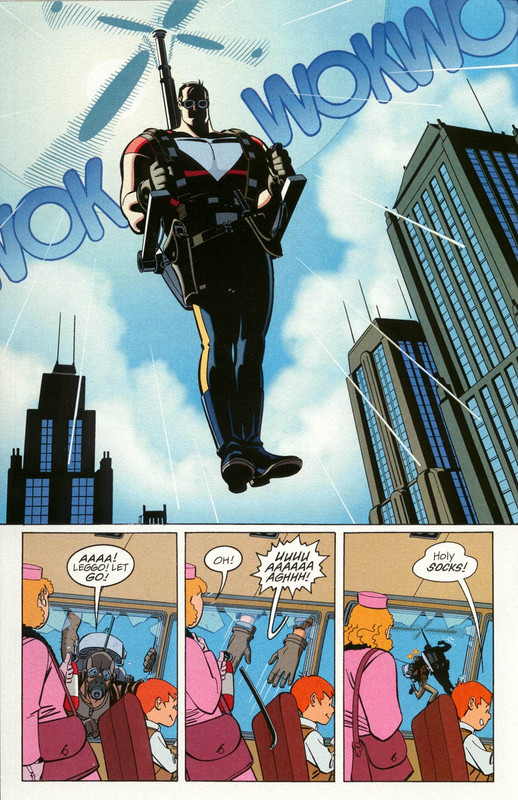 Back in the story, Tom is now 4 years old and is the subject of his father's experiment, to raise a child with pure reason, away from the negative influences of society. The boy is kept in a pressure chamber, where his body grows and adapts to the heavier gravity. However, he does not know human contact, as Sinclair has determined that he must remain in the chamber, until the age of 11. The parents only interact while encased in pressure suits, with Pneuman attending to the boy. Sinclair has been learning from the native Ozu, particular about the plants on the island, and, at his suggestion, feeds Tom the Goloka root, which promotes longevity and higher cognitive awareness. Susan worries about their child, but Sinclair says he is safer there than anywhere. Five years later, Nature calls his bluff and the volcano awakens. Sinclair is killed, crushed by the rubble of their home and the crater and Susan is mortally injured. The pressure chamber opens and her child emerges, in time for his mother to die in his arms. The Ozu climb the slope to find the Strongs and see a sad and wondrous sight... 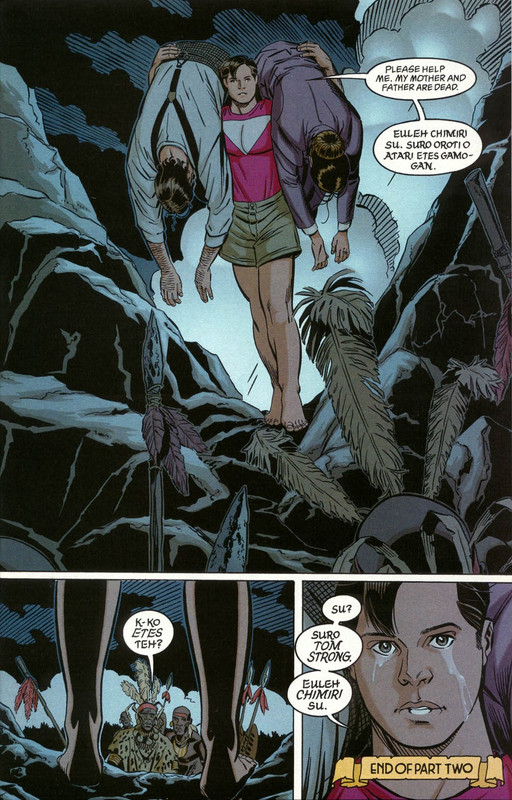 Timmy wipes a tear from his eye and looks for part 3, again missing the excitement, as Tom Strong defeats the blimp bandit, forcing his arm upwards as he fires a harpoon gun, which pierces his lifting envelope, causing the gases to escape in a jet, carrying him uncontrollably off. Tom activates his rotor pack and flies after, plucking the criminal from the air, as he is about to frefall to the streets way below. The passengers cheer at the sight and Timmy tells them to hold it down, he's trying to read! The story moves ahead to 1921. Tom Strong has created an electrical plant that is powered by the geothermal forces of the volcano, providing electrical power to Attabar Teru. he finishes his work, then gets ready for his voyage to the outer world, to see the home of his parents. As they exit, we see how Tom has expanded his father's lab, into something that encompasses the entire crater.... 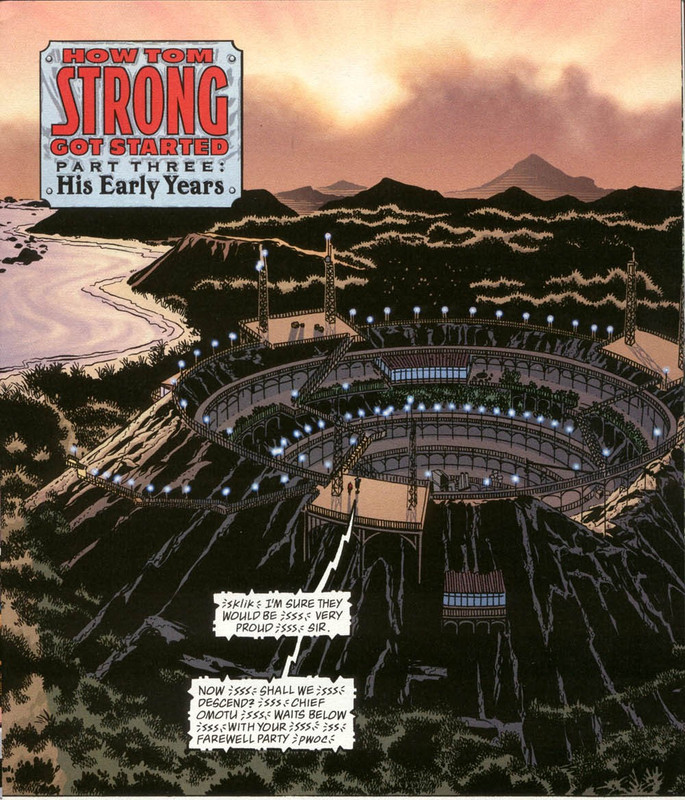 Tom makes his farewells to Chief Omotu, who took him into his tribe and family. He also says farewell to the chief's young daughter, Dhalua, who says she loves Tom. he responds that he loves her like a little sister. He departs on a boat, bound for America, as Dhalua watches him disappear over the horizon, clearly loving him more deeply than an adoptive brother. Tom comes to America and Millennium City, where he encounters the crime lord of the city, the science villain Paul Saveen. Tom dedicates himself to stopping Saveen's corruption.... 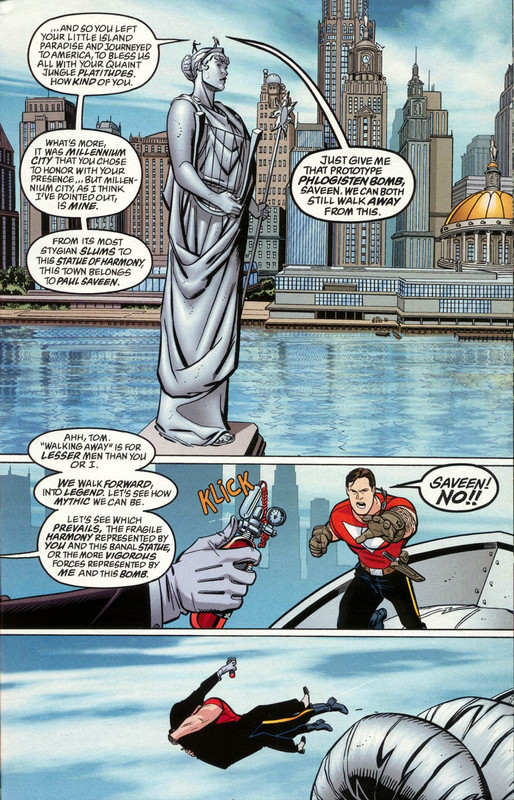 Believing Saveen to be dead, Tom returns to Attabar Teru for some unfinished business: his wedding to Dhalua. Tom demonstrates that he has some of his father on him, as he talks to Dhalua, on their wedding night, about bringing more intelligent life into the world, which makes Dhalua excited. She wants to have a child together; he was talking about brain experiments on a monkey. Luckily, Dhalua proves a stronger influence on Tom. We cut ahead to 1999 and Tom and Dhalua Strong are the proud parents of a teenaged (though technically in her 60s or 70s) daughter, Tesla. We also meet King Solomon, an evolved gorilla who speaks human languages and dresses as one and who has to deal with the Strongmen of America membership requests, while bickering with Pneuman. The assembled family welcome their new readers and remind them that they can follow his adventures monthly, in Tom Strong magazine. Timmy finishes reading his magazine and marvels at the story he just read, as news crews report about the attempted robbery and interview the witnesses. As Timmy walks towards his school, his revelrie is broken by a welcome, from his hero.... 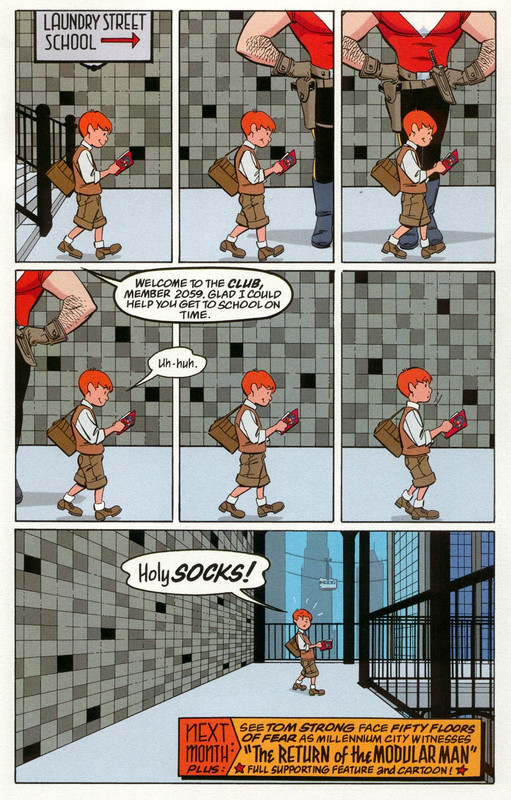 There follows a two page text piece, about the founding of Millennium City, based on the foresight and principles of visionary US President DavidGoodman Croley, in 1886. The city became a vast metropolis, with skyscrapers designed by the renowned architect, Windsor McKay, who hit upon the idea of linking the spire of the buildings with cble cars, to prevent a feeling os isolation of those live above, from those down below. The city became home to larger than life characters, including the criminal genius, Paul Saveen and the city's future hero, Tom Strong. Thoughts: I may have mentioned that Tom Strong is my favorite book of the ABC line. It is filled with adventure and fun, never getting bogged down in violence or a facade of alleged mature storytelling. It is mature in that it treats its hero as intelligent and his family as loving and caring about their greater society. It is both old fashioned and thoroughly modern, mixing the best of both. The characters are great and have a sense of humor, while still displaying real emotion. Moore pokes fun at the tropes of comics and pulp adventure, setting up cliches them knocking them over with a twist. The basic premise is a mix of Edgar Rice Burroughs' Tarzan and Lester Dent's Doc Savage. Tarzan's parents, John Clayton, Lord Greystoke, and his wife, Lady Alice, were shipwrecked off the coast of Africa, in a storm. They survive and build a cabin, but isolation and loneliness prey upon them and dangers lurk all around. John is killed and Alice dies in childbirth, but her baby is taken by Kala, of the great apes, the Mangani. She had lost her own child and responded to the cries of young John, who would be known as Tarzan, the White Ape. Tarzan grows up among the Mangani and other animals of the jungle, including the African natives, some of whom prove to be enemies and some his friends. A European expedition arrives, including a woman, named Jane Porter, and Tarzan finds himself attracted to her and returns to his parent's civilization, before returning to the jungle. Clark Savage Jr was born on the schooner Orion and his father assembled the greatest scientific minds and specialists to train his son to be the peak of human mind and body, a virtual "superman." After meeting in World War 1, Doc assembled a team of specialists to aid him in his adventures, combatting mad criminals and other threats, from their penthouse, atop the tallest skyscraper in New York City (alluded to being the Empire State Building). He is funded by a secret gold mine, in the Latin American land of Hidalgo. He also maintains a Fortress of Solitude, above the Arctic Circle, filled with scientific wonders and treasures he has collected. These characters, along with other pulp and literary heroes inspired the first comic book superheroes as their creators drew inspiration from and blatantly swiped the concepts and characteristics of those heroes. Doc Savage and Phillip Wylie's novel Gladiator, as well as Edgar Rice Burrough's John Carter of Mars, inspired Superman, from his birth on another planet, of heavier gravity, to his Fortress of Solitude, to his nickname as the Man of Steel (Doc Savage is the Man of Bronze). Tarzan influenced every white jungle hero who came along, though his own existence is due to the influence of Rudyard Kipling's Mowgli, from the Jungle Book. Moore goes back to the beginning, to the beginnings of the comic book superhero, to give us a hero for the modern age. He uses those same pulp settings and concepts and mixes it with futurism, to deliver an old fashioned science hero, for the modern age. Moore actually throws in some real science, rather than just the wonder science of too many modern comics, from writers with poor scientific education. Early comic books were dominated by science fiction fans, who took some of the ideas presented in those stories and novels into the worlds of these pulp heroes, blending them into something more. Some had strong backgrounds in science, and intelligence and scientific principles factored into their adventures, like John Broome, on the Flash and Adam Strange. Like doc Savage, Tom Strong is a thinking hero, with brains driving brawn. Like heroes of old, Tom Strong's aging is slowed by the Goloka root, which only grows on Attabar Teru. This allows Tom to be practically ageless, like Superman, though in the world of the story, rather than in publication. It adds more fun to things, as Tesla is a teenager, who was born sometime in the 1930s (maybe 40s), while young Tom is nearly a century old. Moore didn't just stop at the pulps, as he mixed other influences. The pressure chamber, when Tom grows, is an homage to a similar set up in Simon & Kirby's The Double Life of Private Strong, which featured a revamp of The Shield. This hero was the son of a scientist, who, as a toddler is raised in a lab, with a machine strapped to his head, which fed impulses that stimulated his brain activity. When government officials want to shut down the project, he takes the child in a mobile lab, to get away, but runs afoul of foreign agents and is killed. The toddler is found by a kidly farm couple and raised as their son, Lancelot Strong. The adult Lancelot later finds the wreck of the mobile lab and a patriotic costume, meant for him and becomes The shield, battling enemy agents, while Lancelot is also drafted into the Army. The book became the target of DC Comics' ire, who felt the concept was too close to Superman (though more to the sources that Superman was pulled from) and threatened Harvey Comics with a lawsuit and they shut down the book, after two issues. When Moore conceived Watchmen, his original proposal was built around potentially purchasing or licensing the MLJ/Archie heroes, which evolved into using the newly purchased Charlton heroes, which evolved into creating pastiches of them for the story, so the actual characters were free to be integrated into the DCU. Millennium City is a mix of High Ferris' architectural essay, The Metropolis of Tomorrow, which presented ideas for vast cityscapes of high rise buildings (with elevated streets and pathways and bridges that provided apartment buildings, within the support structures), Normal Bel Geddes' Futurama display at the 1939 New York World's Fair, the concepts of Le Corbusier, and fritz Lang's Metropolis. It is a fantastic city of the future, as seen in the late 1800s. Moore makes those old futurist visions real, then assigns their creation to the visionary Windsor Mccay, the creator of Little Nemo in Slumberland. McCay's cartoons were often filled with huge cityscapes and other strange, often massive environments, within Nemo's dreamworld. They were inspired by the building race within new York City, as skyscrapers grew to greater heights, thanks to advances in steel and reinforced concrete, which allowed for taller and more stable structures. The visions of Metropolis and Gotham City came from 1930s new York, with the Empire State Building and the Chrysler Building battling for altitude supremacy, ending with a "dirigible mooring mast" atop the ESB, which never moored an airship. Chris Sprouse is perfect for this. His clean lines and expressive faces add power to the story and strip it to the essentials. This isn't the messy hatching of the Image crowd and their inkers; it's more a throwback to people like Alex Toth and Will Eisner, Reed Crandall and Lou Fine. Characters are physically imposing, but not muscle-bound. Dhalua and Tesla have greater physical stature, making them a match to their partner and father. Tom Strong's look is kept simple, which works to great advantage, making him instantly identifiable. He wear black trousers, with a single strip down the side, recalling classic adventurers, in military trousers. He tops it with a red t-short, with a simple white inverted triangle, recalling Superman's pentagram emblem. Added to that are functional boots and gloves, plus an equipment belt with a couplf of pouches, a knife, and a pistol and holster. Unlike Batman, his utility belt is kept to a bare minimum, going the opposite direction from Liefeld and his ilk, where heroes had utility belts and equipment harnesses with more gear than even Arnold Schwarzenegger could carry. Tom Strong epitomizes what I love about Moore's approach to the line: when everyone else was jumping on current trends and grinding them into the ground, Moore looked back to the beginning and reminded us why icons became iconic, while adding his own touches to them, with benefit of hindsight. Just as the LOEG features commentary about Victorian prejudices and social mores and politics, this has comment about dark and gritty heroes, who have little to set them apart from the villains. Moore gives us pulp heroes and villains, with personality and depth, showing us that you can add layers to the archetype and be modern, rather than just become violent and profane and call it "mature." Throughout the story, Moore has little touches of humor, primarily with the outer structure of Timmy Turbo reading the story, oblivious to the adventure happening outside his window. Timmy will feature in other stories, as well as other Strongmen members, adding a Simon & Kirby kid gang aspect, but with less stereotyping of characters and with more meta fun. Next, the League continues their mission to try to recover the stolen Cavorite, from The Doctor and his assassins. |
|
Confessor
CCF Mod Squad
Not Bucky O'Hare!
Posts: 10,197 
|
Post by Confessor on Oct 7, 2022 2:21:41 GMT -5
Nice idea for a thread, Cody. I'm only familiar with the LoEG comic, which I adore being something of an Alan Moore fanboy. I enjoyed your write up of issue #1, and couldn't really find fault with any of your observations. I also like that you are evaluating the series within the context of Victorian history, literary conventions, and social mores -- all things upon with Moore is an expert. Such a reading is essential to understanding what Moore was trying to achieve in this series, in my view. I've yet to read your observations on issue #2, but I'm looking forward to doing so.
I'll be interested to read your reviews of the ABC comics.
|
|
|
|
Post by Calidore on Oct 7, 2022 8:05:24 GMT -5
I enjoyed Top Ten and Tomorrow Stories very much, and read many of the Doc Savage novels long ago when I collected them, but for some reason I never read Tom Strong. I really should remedy that.
|
|
|
|
Post by mikelmidnight on Oct 7, 2022 11:24:27 GMT -5
Like heroes of old, Tom Strong's aging is slowed by the Goloka root, which only grows on Attabar Teru. This allows Tom to be practically ageless, like Superman, though in the world of the story, rather than in publication. It adds more fun to things, as Tesla is a teenager, who was born sometime in the 1930s (maybe 40s), while young Tom is nearly a century old.
I hate that about Tesla. She's charming, but the fact that she's not matured (which is never true of Young Tom Strong) qualifies her as manifesting one of my pet peeves in a lot of fiction, the "immortal ingenue." Even when we see her in he future, she's still a cutely ineffectual teenager.
|
|
|
|
Post by codystarbuck on Oct 9, 2022 17:52:37 GMT -5
League of Extraordinary Gentleman #3 O'Neill going for an Asian look, with the battle against "the Devil Doctor." Note Mina's very Asian features and coloring, though the same was not done with Quatermain. Creative Team: Alan Moore-writer, Kevin O'Neill-artist, William Oakley-letters, Benedict Dimagmaliw-colors, Scott Dunbier-editor The credits are done as content pieces for a Boy's Book of Horror.....  Synopsis: Synopsis: The group recaps their mission, then Min doles out the assignments. She and Griffin will go to the tea shop of Quong-Lee, who is renowned for his knowledge of the Limehouse district (from Thomas Burke's ATea Shop in Limehouse). Quatermain and Dr Jeckyll will seek information via the opium dens known to Quatermain. Nemo remains on the Nautilus, at Wapping Docks, as it becomes their mobile base. Quatermain doesn't trust Griffin and Mina is less than enamored of his personality and "urges." Meanwhile, the newsvendors of the area sell papers with references to "eruptions on Mars." Mina and Griffin go into the shop and speak to Quong Lee, who only speaks in abstracts, hinting at the information they seek.... 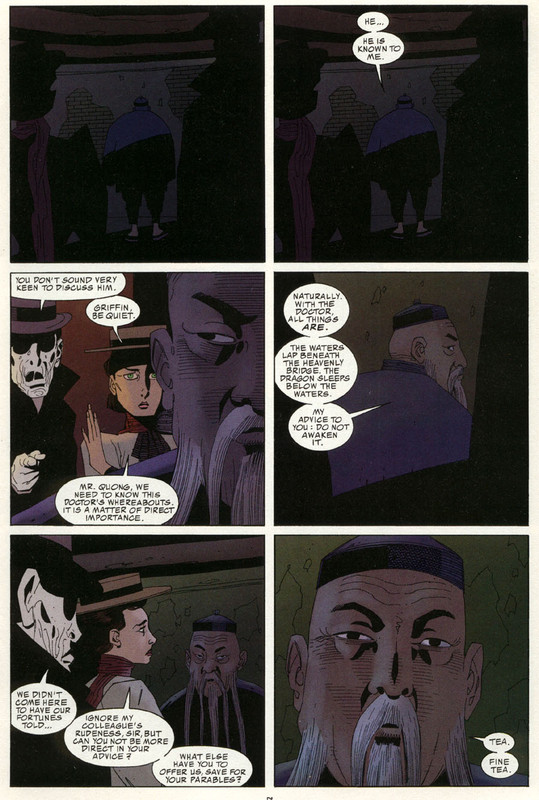 Mina realizes he means that Fu Manchu is somewhere below the water, near the bridge. Quatermain and Jeckyll try the opium dens, where Quatermain is too afraid of Mina's wrath to feed his addiction, but the info isn't prevalent either. They are steered to Shen-Yan, the barber, aka Shanghai Charlie (Mystery of Fu Manchu). They enquire about Ho Ling, but quickly learn that he is in poor favor and very busy, at the moment, as they spy him being tortured, by an evil looking man, in traditional mandarin robes. It is the "Devil Doctor,: himself. They quickly make their excuses and start to leave. The proprietor questions their statement that Ho Ling owed Allan money, as he sold opium and Allan looks like a consumer. Allan thinks fast and says Ho Ling sold them tar, instead of opium and he was looking to get the money back. Jeckyll nearly succumbs to the stress of the situation, but, his reaction saves them, as he seems more like an addict and it amuses the proprietor, who lets them go. They all regroup on the Nautilus and Mina discusses Quong Lee's metaphors about the "dragon below the water." She believes he is referring to the abandoned Rotherhithe Tunnel, from Rotherhithe to Shadwell, which led to the building of a bridge, instead. She believes that the Doctor is using the tunnel remain as a base. 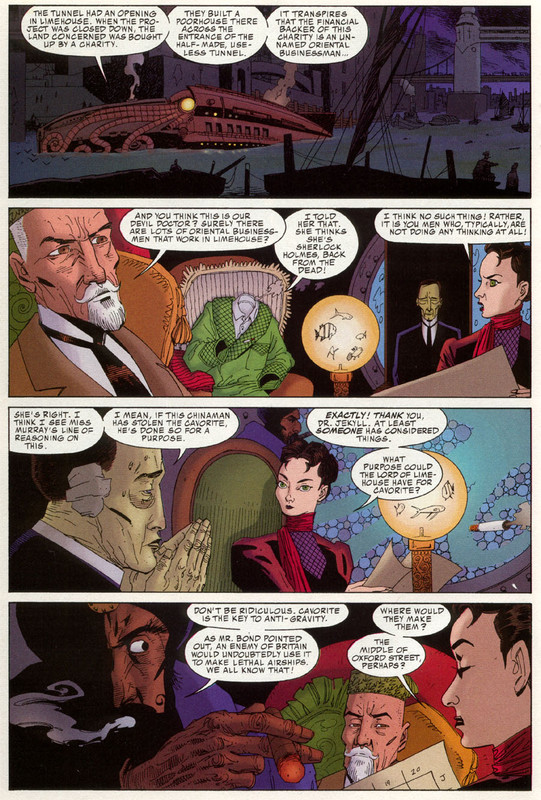 There is a poorhouse near the entrance to the abandoned tunnel. Mina and Quatermain masquerade as a poor couple, seeking a bed for the night, whle Griffin slips in, invisibly. Nemo refuses any further masquerades as servants or beggars and Jeckyll is too afraid of being stressed. Mina an Quatermain are allowed in, but separated. They meet up to search the area, when someone comes along. Quatermain immediately embraces and kisses Mina, to keep up their cover. Mina is angered, but lets it go. They find the tunnel entrance overgrown, but Allan points out it is more overgrown than the rest of the area, so someone is concealing something. The explore further and find Chinese guards, a glass roofed tunnel and a dreadnought.... 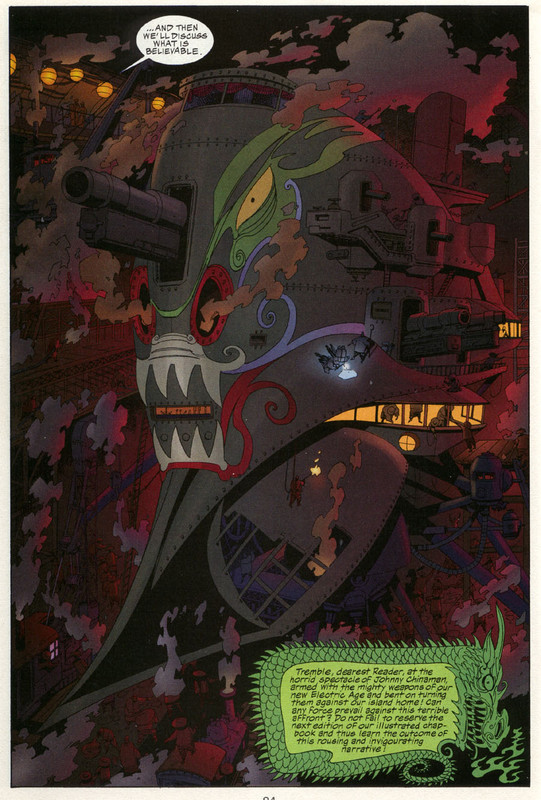 Allan and the Sundered Veil continues, as the Time Traveler takes Allan, Randolph Carter and his great-uncle John, to a future and his own sphinx abode, and tells them of the Morlocks, or Mi-Gos, as they are know, aka abominable snowmen, and their connection to the monsters they witnessed. Thoughts: The League now works as a unit to uncover the base of the "Devil Doctor," aka Fu Manchu, who has stolen the Cavorite, which could allow him to create aerial warships. This is precisely what they find. Here, again, Moore weaves a tail from bits and pieces of Victorian literature and from the standard comic book tropes. He has a team of bickering members, much in the style of the Avengers and other marvel teams, who then have to hunt down Dr Fu Manchu, who has created an aerial dreadnuoght, using the Cavorite he stole from the professor. The Marvel template is mixed with Sax Rohmer, Thomas Burke, HG Wells and some Jules Verne, while also making social commentary on several points. Nemo has had enough of playing the subservient to white people, demonstrating the Imperial prejudices, as he is a rebel of the Empire. It also shows that India was divided against itself, with a caste system that was just as confining, if not more so, than the English class system. For all his rejection of "English values," Nemo is still a product of his own culture's prejudices. The others are a product of their Victorian society, mostly members of the upper classes. Mina is probably the only one who truly challenges the norm, though even she is caught up in Victorian sexual and class repression. She may masquerade as a poor woman, but she has known status and judges others from on high. The group is a mixture of virtue and vice. Fu Manchu, at the time of the comics creation, was still entirely under copyright and the Rohmer estate also held a trademark on the character. Thus, Moore can only allude to Fu Manchu, through nicknames and descriptions. Now, the earliest Fu Manchu novels are in the public domain, making the character and anything directly tied to those earliest works, available, though, like Tarzan, the trademark muddies the waters for commercial use. Aerial warfare was fast becoming a thing, by this point. Balloons had been in existence since the late 18th century and their military uses were exploited during the American Civil War, as artillery observation posts. They provided a vantage point for more accurate targeting of the more advanced artillery pieces that were developed. European nations watched the Civil War with great interests, sending military officers to act as observers, on both sides. They watched the rapid technological advances that the war inspired, coupled with the growing American industrialization. Artillery became more sophisticated and more deadly, gaining greater range and accuracy. Shells became more devastating. Firearms were more advanced breechloaders, making for more rapid reloading. They also gained in accuracy. Repeating weapons were being developed. Ironclad ship appeared and fought in battle, as the USS Monitor fought the CSS Virginia (aka the Merrimac). The Confederates built a working submersible, in the CSS Hunley, though it proved fatal to the crew. Graf Ferdinand von Zeppelin had been an observer of the Civil War and his observations of balloons showed the potential for not just aerial observation but aerial bombardment. After he retired from the army, he put his energies into the development of rigid airships, eventually launching the LZ1, in 1900. Non-rigid airships had been flying since the 1850s and patents for rigid airships began appearing in the 1870s. Such craft fueled Victorian writers, who followed scientific advances. The Civil War also showed that war was becoming more destructive and it was reaching beyond the battlefield. Cities had known long sieges by invaders, before. Now they faced long range bombardment, from artillery and these airship developments meant that bombs could easily fall from the air. Jules Verne wrote Robur the Conqueror (aka Clipper of the Clouds) in 1886, featuring a heavier-than-air ship, the Albatross, lifted by multiple propellers, attached to columns on the superstructure. It was the first "helicarrier." Verne had already written about air travel in 5 Weeks in a Balloon, in 1863 (which got mixed into the film version of Around the World in 80 Days, leading people to believe that Phileas Fogg traveled by balloon, in the original). So, Moore is sticking to what people were writing, in their speculative works. Also lurking in the background are snippets of foreshadowing for the War of the Worlds. Right now, Moore is setting up the League, via their initial adventure. The real story, though, is their part in battling Martian invaders. Moore teases us with this expectation and lets our imaginations simmer with potential images. An interesting part to this series is the use of actual translated dialogue, without giving it to us in English. Chinese characters speak in word balloons with actual Chines writing characters. If you can read such things, you can read their dialogue. If not, the reactions and body language give you the gist of things and you don't miss out. It is another layer to the story, much as Moore did with the visual clues and references throughout Watchmen, many of which you don't register until late in the story, when things become clearer. Moore and O'Neill suggest even more for you to absorb, whether it is architecture, background characters, little side actions on a panel, general attitudes or other suggestions. O'Neill adds Victorian signs and advertisements and lots of period detail. The back cover is filled with fake and real Victorian adds, including an add for the series which it says missing is worse than dying of croup, like a poor chimney-sweep! This issue also features the first letters column. One or two writers adopt the style of the period, while another praises Moore for making them feel stupid, for not knowing some of the characters, which the editor says their chief delight, as Englishmen, is to make Americans and other colonials feel stupid. Another whines about the lack of a glossary to identify said characters and the response is why deprive you fo te joy of searching for the answers, rather than spoonfeeding it to you? asadly, this is the lament of the Internet Age, where the joy of the hunt is gone and acquired knowledge has less value. Comedian Stewart Lee has remarked on this, in his act, though uses the subject of porn to illustrate it! (Warning, NSFW subject matter/language and satire) The Rotherhithe Tunnel, or Thames Tunnel, was a real underground/underwater tunnel. At first, it was more of a tourist attraction, before it was taken over for underground trains. here, it went unfinished and a bridge was built over it, while Fu Manchu uses it as a base to build his dreadnought. This also reflects the Fu Manchu stories and films, as The Face of Fu Manchu features a secret lair, beneath the Thames River. Shanghai Charlies, aka Shan yen, the Barber, is also from the Mystery of Fu Manchu and the Doctor uses tortures like seen in the comic and worse. here, he uses caustic paint to write on Ho ling's body, both torturing him and sending a warning. The translation had some debate, but it seems to be a haiku.... The stars are destiny's verse A man without scars Is an unwritten book. Fu Manchu is scarring this haiku into the skin of Ho Ling. Ho Ling was another creation of Thomas Burke. I can't begin to cover every reference in here, so I will refer you to Jess Nevin's invaluable website and his annotations of the series. Mr Nevins helped point me to all kinds of great stuff to explore, from Victorian literature to the French Belle Epoque and later pulp works, to other pulp literature, in America and abroad, up through the 1930s. If you want to know about the Nyctalope or Lord Ruthven, the Vampire, he's your man with the answer. Sadly, his books are mostly out of print and very pricey on the secondary market. He has LOEG annotations up through the first issue of Tempest, but had to concentrate on his paying work, at that point. The DC book annotations were collected and published by Monkey Brain Books, but are out of print, though a bit of hunting may find them in affordable prices. Still, the annotations are online and there is a League wiki. Next: Tom Strong battles The Modular Man!
|
|
|
|
Post by berkley on Oct 10, 2022 18:39:04 GMT -5
The visual design of Tom Strong is such a turn-off for me that I've never read more than one or two isolated issues. I do like the concept and feel no doubt that Moore handled it masterfully, so perhaps someday I'll try it from the beginning and see if I can't overcome my distaste for that grotesquely disproportionate physique with the overblown arms, shoulders, and chest attached to relatively normal-looking lower body. But it'll take some doing, because it just looks terrible to my eyes. Maybe I should hunt around and see if I can't find Moore's scripts online somewhere, and just read those.
|
|

































